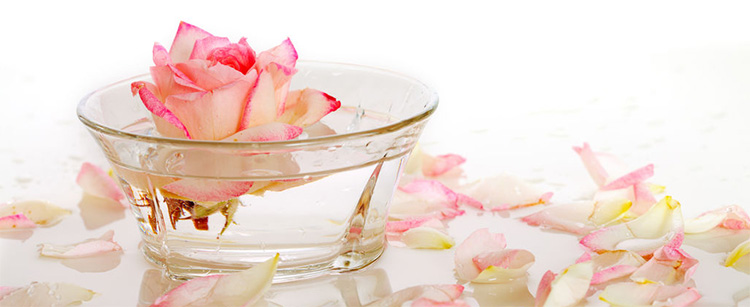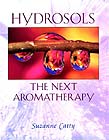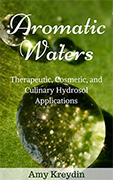Hydrosol Uses

Hydrosols can be used in an endless number of ways. Most hydrosols are virtually clear and water soluble. Misting and spraying hydrosols is the most popular way of using them. When purchasing hydrosols in 1 oz. - 8 oz. sizes, they often (but not always) are sold in bottles with sprayer tops. You can also purchase larger bulk sizes of hydrosols and separately purchase bottles of varying sizes with sprayer tops. Look to the Bottles and Packaging section of AromaWeb's Aromatherapy Business Directory for bottle suppliers.

Use the list shown below as inspiration for discovering your own favorite uses for hydrosols. Although hydrosols are generally considered safer to use than their significantly more concentrated essential oil counterparts, do pay attention to the Hydrosol Safety Guidelines page plus any individual hydrosol precautions.
Hydrosols can be blended to achieve greater synergism between the individual hydrosols. Experiment and create unique aromatic combinations.
Hydrosols Sprays:
- Facial Spray: Close your eyes and lightly mist your face.
- Body Spray: Lightly mist your body to feel cooled and refreshed. Depending on the aromatic intensity of the hydrosol used, your body will be left lightly fragranced.
- Gentle Hair Fragrancing Spray: Mist your hair to leave it hydrated and lightly fragranced.
- Deodorant Spray: Mist under arms and as needed elsewhere (avoid directly spraying genitals) to help prevent body odor. Hydrosols with antibacterial properties can be especially helpful in minimizing body odor.
- Foot Spray: Mist the tops and bottoms of feet to help control foot odor and to refresh your feet. Hydrosols with antibacterial properties can be especially helpful in minimizing foot odor.
- Anti-Itch Spray: Peppermint Hydrosol and Witch Hazel Hydrosol can help to ease itching caused by dry skin, dandruff and insect bites.
- Air Freshening Spray: Use hydrosols to freshen a room and to benefit from the emotional and therapeutic properties that are inherent with the chosen hydrosol(s). Simply spray the hydrosol within your space as you would most any room mist. Do be careful to avoid furniture, other people, pets, open beverages and foods. Hydrosols can be used in place of water within AromaWeb's Air Freshener Recipe.
- Linen Spray: Use hydrosols to freshen and fragrance sheets, towels and other linens. Hydrosols can be used in place of water within AromaWeb's Bed Linen Recipe.
- Aphrodisiac Room Mist: Look to AromaWeb's Aromatherapy Aphrodisiacs article for a clear definition of an aromatic aphrodisiac. The article explains how aphrodisiacs can help enhance sexual desire. One or more of the hydrosols shown below may possibly act as an aphrodisiac for you: Roman Chamomile, Frankincense, Geranium, Jasmine, Lavender, Lemon Balm (Melissa), Nutmeg, Patchouli, Peppermint, Rose, Spearmint, and Vetiver.
- Car Freshening Spray: Mist the interior of your car, avoiding polished, painted and fragile surfaces.
- Garment Freshening Spray: Lightly spray clothes (avoid sensitive and delicate fabrics) to impart a gentle aroma and to help eliminate unpleasant musty, smoky or other odors.
- Calming Spray: Mist your room, body and face using hydrosols that are reported to help reduce stress and anxiety. Angelica Root, German Chamomile, Roman Chamomile, Elderberry, Labrador Tea, Lavender, Melissa, Neroli, Patchouli, Rose and Vetiver hydrosols can help induce a sense of calm.
- Meditation/Prayer Spray: Hydrosols can be used to help enhance meditation and prayer. Angelica Root, Frankincense Hydrosol, Helichrysum Hydrosol Holy Basil (Tusli) and White Sage Hydrosol are those that immediately come to mind as being the most widely used hydrosols for spiritual applications.
- Purification Spray: Hydrosols like Sweetgrass Hydrosol and White Sage Hydrosol can be used to help purify and cleanse a room or area.
- Chakra Sprays: Hydrosols can be incorporated into work on the seven primary Chakras. Although AromaWeb's 9-page Aromatherapy for Chakras section does not contain specific information on hydrosol use, the Chakra information is detailed and can help you adapt hydrosols for use within your chakra work. (i.e. it's pretty straightforward that since Angelica Root, Frankincense, Patchouli, Vetiver are listed as essential oils that are helpful in balancing the Root Chakra, their hydrosol counterparts can also be used).
- Wound Sprays: Angelica Root, Cistus (Rock Rose), Geranium, Helichrysum, Lavender, Tea Tree and Witch Hazel hydrosols can be used to help kill germs and promote the healing of minor wounds, cuts and abrasions.
- Monster Repellent: Calming hydrosols can be used to help calm and soothe babies and children. AromaWeb's Monster Repellent Recipe is simply Neroli Hydrosol.
Other Common Hydrosol Applications:
- Facial Toner: Cistus (Rock Rose), Clary Sage, Rose, Neroli and Witch Hazel Hydrosols make wonderful toners. Other hydrosols that are heralded for their skin care use include Cucumber, Geranium, Lavender, Lemon Balm (Melissa), and Patchouli. Lemon Balm and Grapefruit Hydrosols are quite helpful for oily skin.
- Men's Aftershave: Hydrosols can be adapted for use as a men's aftershave.
- Styptic (helps stop bleeding of minor cuts and wound): Cistus (Rock Rose) Hydrosol and Geranium Hydrosol are reported to help stop minor bleeding.
- Anti-Inflammatory: German Chamomile, Roman Chamomile, and Helichrysum are amongst the hydrosols that are the most potent anti-inflammatories. Other hydrosols with varying level of anti-inflammatory action include Clary Sage, Geranium, Holy Basil (Tulsi), Lavender, Lemon Balm (Melissa), Peppermint, Rose, Rosemary, Spearmint, Vetiver, Witch Hazel and Yarrow.
- Compresses: Hydrosols can be chilled or warmed and used in place of water for compresses.
- Aromatic Substitute for Water in Personal Care Recipes: Enhance your lotion, cream, room mist and other recipes that call for water. Substitute skin-safe hydrosols for the water called for in your recipes.
- Baby Wipe Moistening Solution: Handmade, natural baby wipes can be made using anti-inflammatory and calming hydrosols like Neroli Hydrosol, German Chamomile Hydrosol or Lavender Hydrosol
- Finger Bowl: Hydrosol can be used in place of water within finger bowls.
Culinary and Internal Uses
Hydrosols are also used for their wonderful and diverse flavors for culinary and beverage flavoring purposes. Additionally, hydrosols have a wonderful reputation for their therapeutic benefit when used internally.
Such usage, however, requires more care and precautionary awareness than topical or room fragrancing hydrosol usage. Hydrosols are water-based and are more prone to contamination than essential oils. When improperly stored or handled, hydrosols can become contaminated and potentially unsafe to consume. Additionally, some companies that sell products specifically intended for use in topical and personal care applications may add alcohol or preservatives to their hydrosols in order to help reduce the chance of microbial contamination. If you intend to use hydrosols for internal use or consumption, it's best to learn to distill your own or ensure that you are buying your hydrosols from a trusted supplier that can tell you the distillation date and assure you that preservatives have not been added.
AromaWeb is host to millions of individuals from around the world. AromaWeb's visitors have varying levels of awareness of aromatherapy safety principles. English is a second language to some AromaWeb visitors, and AromaWeb's text is sometimes run through automated language translators by those that do not know English (such translators can alter the intended meaning of some text). Additionally, some individuals skim text so fast that they can miss important safety recommendations. For these reasons, AromaWeb does not discuss or provide suggestions regarding the internal use of essential oils or hydrosols.
The books shown below discuss the internal and culinary uses of hydrosols.
Helpful Sources of Information About Hydrosols:

Hydrosols: The Next Aromatherapy
Author: Suzanne Catty

Understanding Hydrolats: The Specific Hydrosols for Aromatherapy
Authors: Len Price and Shirley Price

375 Essential Oils and Hydrosols
Author: Jeanne Rose

Essential Waters: Hydrosols, Hydrolats & Aromatic Waters
Author: Marge Clark

Aromatic Waters: Therapeutic, Cosmetic, and Culinary Hydrosol Applications
Author: Amy Kreydin
